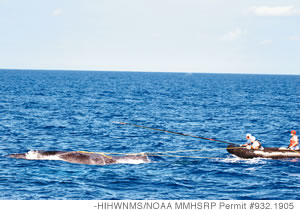Saving Whales From Man And Time

Wednesday - December 23, 2009
| Share
 Del.icio.us
Del.icio.us
|
They are members of one of Hawaii’s most highly skilled teams. Their missions are filled with risky maneuvers that require precision and patience.
They train for a season that lasts only a few months and their toughest opponent is often ... time.
They are members of NOAA’s Hawaiian Islands Humpback Whale National Marine Sanctuary and Hawaiian Islands Disentanglement Network, who respond to whale entanglements in Hawaiian waters each whale season.
On Dec. 1, team members were pressed into duty once again when a 2-year-old humpback whale was discovered entangled in 200-400 feet of polypropylene fishing line off Launiopoko, Maui.
And once again, they were racing against the clock.
“One of the reports told us that the rope or some of the rope went through the mouth, so this was considered a life-threatening entanglement,” says David Schofield, marine mammal stranding response coordinator, NOAA Fisheries Service Pacific Islands regional office.
Team members say the line crossed tightly over the whale’s head behind the blowhole, forming a knot with two lines that trailed for hundreds of feet. What complicated this disentanglement even more was the juvenile whale was traveling so close to its mother and a large male. Rough seas added to the crisis.
“It was our hope the whale would slow down over time and the weather would change and get into a position where we can work with it,” says Schofield.
After several days of monitoring, the crew attached a sea anchor device on the whale that resembled an underwater parachute. The technique is reminiscent of old whaling days
“They used to harpoon whales - harpoon them and then weigh them down with kegs like you see on the movie Jaws, where they’re trying to slow the shark down,” says Schofield.
From there it becomes a waiting game that can last anywhere from a day to weeks. In this case it lasted five days.
The U.S. Coast Guard and the State Department of Land and Natural Resources assisted in the effort. The response team used telemetry equipment to locate the energetic animal in waters west of Molokai.
Late in the afternoon on Dec. 6, the juvenile humpback whale was set free. Rescuers were able to approach close enough to cut the entangled lines by hooking a knife to the rope near the whale’s back. The knife was then attached to another sea anchor and after 10 minutes it sliced through the line, freeing the whale.
When the all-clear was given and the line removed, the young whale appeared to be in good shape and swam away with its mother and escort. The response team then gathered approximately 350 feet of heavy-gauge yellow polypropylene line.
The culprit once again was man.
An estimated 15,000 whales will enter our waters through the month of March, providing opportunities for spectacular shows out on the ocean. But the high numbers also increase the chance for other entanglements. In all, 11 whales have been freed by Hawaii’s humpback whale disentanglement program since its start in 2003.
While all rescues are dangerous, team members say the rewards outweigh the risks. Their main goal after each mission is to gain information on how to reduce the threat of future entanglements.
The obvious solution is to do our part, especially those who use the ocean for recreation and business. What you leave behind is your kuleana, your responsibility. Thankfully there is a team of trained professionals willing to lend a hand to free animals victimized by our carelessness.
Remember, we are guests in their home. As Grandma used to say, “Leave it better than you found it.”
Our whales and other animals in the ocean are counting on it.
E-mail this story | Print this page | Comments (0) | Archive | RSS Comments (0) |
Most Recent Comment(s):













